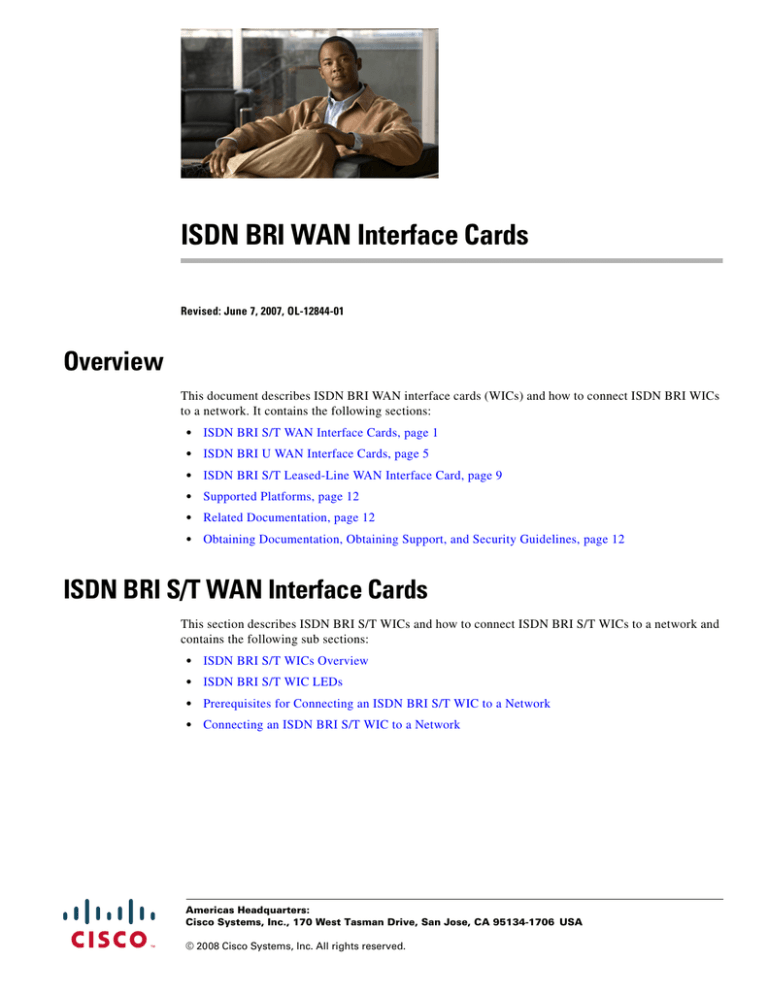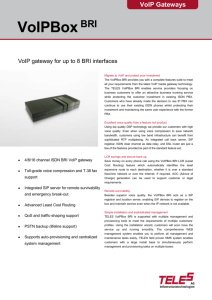
ISDN BRI WAN Interface Cards
Revised: June 7, 2007, OL-12844-01
Overview
This document describes ISDN BRI WAN interface cards (WICs) and how to connect ISDN BRI WICs
to a network. It contains the following sections:
•
ISDN BRI S/T WAN Interface Cards, page 1
•
ISDN BRI U WAN Interface Cards, page 5
•
ISDN BRI S/T Leased-Line WAN Interface Card, page 9
•
Supported Platforms, page 12
•
Related Documentation, page 12
•
Obtaining Documentation, Obtaining Support, and Security Guidelines, page 12
ISDN BRI S/T WAN Interface Cards
This section describes ISDN BRI S/T WICs and how to connect ISDN BRI S/T WICs to a network and
contains the following sub sections:
•
ISDN BRI S/T WICs Overview
•
ISDN BRI S/T WIC LEDs
•
Prerequisites for Connecting an ISDN BRI S/T WIC to a Network
•
Connecting an ISDN BRI S/T WIC to a Network
Americas Headquarters:
Cisco Systems, Inc., 170 West Tasman Drive, San Jose, CA 95134-1706 USA
© 2008 Cisco Systems, Inc. All rights reserved.
ISDN BRI S/T WAN Interface Cards
ISDN BRI S/T WICs Overview
The ISDN BRI S/T WICs connect to an ISDN network through an external NT1 device. This interface
is also known as an S/T interface. There are three ISDN BRI S/T WICs:
Note
Warning
You can distinguish between WIC36 and WIC models of an ISDN BRI WIC by the location and labeling
of the LEDs and by the number and location of cutouts in the faceplate.
•
1-port ISDN BRI WIC with S/T interface (WIC36-1B-S/T) (see Figure 44)
•
1-port ISDN BRI WIC with S/T interface (WIC-1B-S/T) (see Figure 45)
•
1-port ISDN BRI WIC with S/T interface, version 3 (WIC-1B-S/T-V3) (see Figure 46)
To comply with the Telcordia GR-1089 NEBS standard for electromagnetic compatibility and safety,
connect the 1-port ISDN BRI WIC with S/T interface, version 3 (WIC-1B-S/T-V3) only to intra-building
or non-exposed wiring or cabling. The intra-building port(s) of the equipment or subassembly must
not be metallically connected to interfaces that connect to the OSP or its wiring. These interfaces
are designed for use as intra-building interfaces only (Type 2 or Type 4 ports as described in
GR-1089-CORE, Issue 4) and require isolation from the exposed OSP cabling. The addition of Primary
Protectors is not sufficient protection in order to connect these interfaces metallically to OSP wiring.
Figure 44
WIC36-1B-S/T Front Panel
BRI S/T port
B1
BRI
S/T
B2
SEE MANUAL BEFORE INSTALLATION
Figure 45
41225
LEDs
WIC-1B-S/T Front Panel
SEE MANUAL BEFORE INSTALLATION
Figure 46
BRI
S/T
41221
OK
B2
B1
BRI S/T port
WIC-1B-S/T-V3 Front Panel
BRI S/T port
SEE MANUAL
BEFORE INSTALLATION
B1
B2
ISDN BRI S/T
OK
95120
WIC
1B-S/T
V3
ISDN BRI WAN Interface Cards
2
OL-12844-01
ISDN BRI S/T WAN Interface Cards
ISDN BRI S/T WIC LEDs
The ISDN BRI S/T WIC LEDs are shown in Figure 44, Figure 45, and Figure 46. The functions of the
LEDs are described in Table 9.
Table 9
ISDN BRI S/T WIC LEDs
LED
Description
B1
ISDN connection on B1 channel when blinking.
B2
ISDN connection on B2 channel when blinking.
OK
ISDN port has established a connection with the central office switch (D channel).
Prerequisites for Connecting an ISDN BRI S/T WIC to a Network
Before connecting a WIC to the network, ensure that the WIC is installed in the router, the equipment is
properly grounded, and you have the proper cables for connecting the WIC to the network. This section
describes the preparation necessary before connecting an ISDN BRI S/T WIC to the network.
Installing a Cisco ISDN BRI S/T WAN Interface Card
Install the Cisco WIC according to the instructions in Installing Cisco Interface Cards in Cisco Access
Routers.
Note
Older WIC36-1B-S/T, WIC36-1B-U, CPAWIC36-1B-S/T, or CPAWIC36-1B-U interface cards mount
only in the W1 slot of a 2-slot network module and provide a single BRI interface. Newer WIC-1B-S/T
or WIC-1B-U interface cards can mount in either slot of a 2-slot network module. For more information
on BRI network modules, see the network module documentation located at:
http://www.cisco.com/en/US/products/hw/modules/ps2797/tsd_products_support_series_home.html
Grounding
Ensure that the equipment you are working with is properly grounded. For instructions on grounding
your WIC, see Installing Cisco Interface Cards in Cisco Access Routers.
Cables
Use a straight-through RJ-48C-to-RJ-48C BRI cable (not included) to connect an ISDN BRI S/T WIC
to a network.
Setting Jumpers on ISDN BRI WICs
The WIC-1B-S/T, WIC-1B-S/T-V3, and WIC-1B-U interface cards do not have termination jumpers.
Note
For long-distance point-to-point configuration, and for the last station in point-to-multipoint
configuration, use an external 100-ohm terminator.
ISDN BRI WAN Interface Cards
OL-12844-01
3
ISDN BRI S/T WAN Interface Cards
The WIC36-1B-S/T, WIC36-1B-U, CPAWIC36-1B-S/T, and CPAWIC36-1B-U interface cards have two
termination jumpers, labeled J1 and J2. Before installing a WIC36-1B-S/T, WIC36-1B-U,
CPAWIC36-1B-S/T, or CPAWIC36-1B-U interface card, ensure that the termination jumpers are set
appropriately for your installation.
The jumpers are factory-configured in the B position. Keep the jumpers in this position to use the ISDN
BRI WIC in a point-to-point connection or as the last device on the line of a passive-bus connection. Set
the termination jumpers to the A position to use the ISDN BRI WIC in a passive-bus connection in which
it is not the last device on the line. The jumpers are shown in Figure 47.
Figure 47
Jumper Locations on the Older ISDN BRI WIC
A
J1
J2
No termination
B
J1
J1
J2
100 Ohms termination
Termination jumpers
H8586
J2
Connecting an ISDN BRI S/T WIC to a Network
Warning
Hazardous network voltages are present in WAN ports regardless of whether power to the unit is OFF
or ON. To avoid electric shock, use caution when working near WAN ports. When detaching cables,
detach the end away from the unit first. Statement 1026
Warning
The ISDN connection is regarded as a source of voltage that should be inaccessible to user contact.
Do not attempt to tamper with or open any public telephone operator (PTO)-provided equipment or
connection hardware. Any hardwired connection (other than by a nonremovable,
connect-one-time-only plug) must be made only by PTO staff or suitably trained engineers.
Statement 23
To connect an ISDN BRI S/T WIC to a network, follow these steps:
ISDN BRI WAN Interface Cards
4
OL-12844-01
ISDN BRI U WAN Interface Cards
Step 1
Confirm that the router is turned off.
Warning
To comply with the Telcordia GR-1089 NEBS standard for electromagnetic compatibility and safety,
connect the 1-port ISDN BRI WIC with S/T interface, version 3 (WIC-1B-S/T-V3) only to intra-building
or non-exposed wiring or cabling. The intra-building port(s) of the equipment or subassembly must
not be metallically connected to interfaces that connect to the OSP or its wiring. These interfaces
are designed for use as intra-building interfaces only (Type 2 or Type 4 ports as described in
GR-1089-CORE, Issue 4) and require isolation from the exposed OSP cabling. The addition of Primary
Protectors is not sufficient protection in order to connect these interfaces metallically to OSP wiring.
Step 2
Connect one end of a straight-through RJ-48C-to-RJ-48C cable to the RJ-48C port on the ISDN BRI S/T
WIC.
Step 3
Connect the other end of the cable to the NT1 device, as shown in Figure 48.
SEE MANUAL BEFORE INSTALLA
BRI
S/T
TION
BRI S/T port (RJ-48C)
41193
Straight-through
RJ-48C-to-RJ-48C
cable
OK
B2
Connecting an ISDN BRI S/T WIC to an NT1 Device
B1
Figure 48
NT1 device
S/T port
Step 4
Connect the NT1 device to the ISDN wall jack according to the documentation that came with the NT1
device.
Step 5
Turn on power to the router.
Step 6
Check that the OK LED goes on, which indicates that the ISDN port has established a connection with
the central office switch.
ISDN BRI U WAN Interface Cards
This section describes how to connect ISDN BRI U WICs to a network and contains the following
sections:
•
ISDN BRI U WICs Overview
•
ISDN BRI U WIC LEDs
•
Prerequisites for Connecting an ISDN BRI U WIC to a Network
•
Connecting an ISDN BRI U WIC to a Network
ISDN BRI WAN Interface Cards
OL-12844-01
5
ISDN BRI U WAN Interface Cards
ISDN BRI U WICs Overview
The 1-port ISDN BRI U WICs contain an integrated NT1 device. This interface is also known as a
U interface. There are three ISDN BRI U WICs:
Note
You can distinguish between WIC36 and WIC models of an ISDN BRI WIC by the location and labeling
of the LEDs and by the number and location of cutouts in the faceplate.
•
1-port ISDN BRI WIC with integrated NT1 device (WIC36-1B-U) (see Figure 49)
•
1-port ISDN BRI WIC with integrated NT1 device (WIC-1B-U) (see Figure 50)
•
1-port ISDN BRI WIC with integrated NT1 device, version 2(WIC-1B-U-V2) (see Figure 51)
Figure 49
WIC36-1B-U Front Panel
B1
BRI
U
B2
SEE MANUAL BEFORE INSTALLATION
Figure 50
41226
NT1
BRI U port
LEDs
LED
WIC-1B-U Front Panel
BRI
U
SEE MANUAL BEFORE INSTALLATION
Figure 51
41223
NT1
B2
B1
BRI U port
WIC-1B-U-V2 Front Panel
SEE MANUAL
BEFORE INSTALLATION
B1
B2
ISDN BRI U
NT1
WIC
1B-U
V2
95121
BRI U port
ISDN BRI U WIC LEDs
The ISDN BRI U WIC LEDs are shown in Figure 49, Figure 50, and Figure 51. The functions of the
LEDs are described in Table 10.
ISDN BRI WAN Interface Cards
6
OL-12844-01
ISDN BRI U WAN Interface Cards
Table 10
ISDN BRI U WIC LEDs
LED
Description
B1
ISDN connection on B1 channel when blinking.
B2
ISDN connection on B2 channel when blinking.
OK
ISDN port has established a connection with the central office switch (D channel).
Prerequisites for Connecting an ISDN BRI U WIC to a Network
Before connecting a WIC to the network, ensure that the WIC is installed in the router, the equipment is
properly grounded, and you have the proper cables for connecting the WIC to the network. This section
describes the preparation necessary before connecting an ISDN BRI U WIC to the network.
Installing a Cisco ISDN BRI S/T WAN Interface Card
Install the Cisco WIC according to the instructions in Installing Cisco Interface Cards in Cisco Access
Routers.
Note
Older WIC36-1B-S/T, WIC36-1B-U, CPAWIC36-1B-S/T, or CPAWIC36-1B-U interface cards mount
only in the W1 slot of a 2-slot network module and provide a single BRI interface. Newer WIC-1B-S/T
or WIC-1B-U interface cards can mount in either slot of a 2-slot network module. For more information
on BRI network modules, see the network module documentation located at:
http://www.cisco.com/en/US/products/hw/modules/ps2797/tsd_products_support_series_home.html
Grounding
For instructions on grounding your WIC, see Installing Cisco Interface Cards in Cisco Access Routers.
Cables
Use a straight-through RJ-48C-to-RJ-48C BRI cable (not included) to connect an ISDN BRI U WIC to
a network.
Setting Jumpers on ISDN BRI WICs
The WIC-1B-S/T and WIC-1B-U interface cards do not have termination jumpers. The WIC36-1B-S/T,
WIC36-1B-U, CPAWIC36-1B-S/T, and CPAWIC36-1B-U interface cards have two termination jumpers,
labeled J1 and J2. Before installing a WIC36-1B-S/T, WIC36-1B-U, CPAWIC36-1B-S/T, or
CPAWIC36-1B-U interface card, ensure that the termination jumpers are set appropriately for your
installation.
The jumpers are factory-configured in the B position. Keep the jumpers in this position to use the ISDN
BRI WIC in a point-to-point connection or as the last device on the line of a passive-bus connection. Set
the termination jumpers to the A position to use the ISDN BRI WIC in a passive-bus connection in which
it is not the last device on the line. The jumpers are shown in Figure 52.
ISDN BRI WAN Interface Cards
OL-12844-01
7
ISDN BRI U WAN Interface Cards
Figure 52
Jumper Locations on the Older ISDN BRI WIC
A
J1
J2
No termination
B
J1
J1
J2
100 Ohms termination
Termination jumpers
H8586
J2
Connecting an ISDN BRI U WIC to a Network
Warning
Hazardous network voltages are present in WAN ports regardless of whether power to the unit is OFF
or ON. To avoid electric shock, use caution when working near WAN ports. When detaching cables,
detach the end away from the unit first. Statement 1026
Warning
The ISDN connection is regarded as a source of voltage that should be inaccessible to user contact.
Do not attempt to tamper with or open any public telephone operator (PTO)-provided equipment or
connection hardware. Any hardwired connection (other than by a nonremovable,
connect-one-time-only plug) must be made only by PTO staff or suitably trained engineers.
Statement 23
To connect an ISDN BRI U WIC to a network, follow these steps:
Step 1
Warning
Confirm that the router is turned off.
To comply with the Telcordia GR-1089 NEBS standard for electromagnetic compatibility and safety,
connect the 1-port ISDN BRI WIC with U interface, version 2 (WIC-1B-U-V2) only to intra-building or
unexposed wiring or cable. The intra-building port(s) of the equipment or subassembly must not be
metallically connected to interfaces that connect to the OSP or its wiring. These interfaces are
ISDN BRI WAN Interface Cards
8
OL-12844-01
ISDN BRI S/T Leased-Line WAN Interface Card
designed for use as intra-building interfaces only (Type 2 or Type 4 ports as described in
GR-1089-CORE, Issue 4) and require isolation from the exposed OSP cabling. The addition of Primary
Protectors is not sufficient protection in order to connect these interfaces metallically to OSP wiring.
Step 2
Connect one end of a straight-through RJ-48C-to-RJ-48C cable to the RJ-48C port on the ISDN BRI U
WIC.
Step 3
Connect the other end of the cable directly to the ISDN wall jack as shown in Figure 53.
Figure 53
Connecting an ISDN BRI U WIC to an ISDN Wall Jack
NT1
B2
B1
BRI U port
(RJ-48C)
BRI
U
SEE MANUAL BEFORE INSTALLAT
ION
41192
Straight-through
RJ-48C-to-RJ-48C cable
RJ-48C jack
Step 4
Turn on power to the router.
Step 5
Check that the OK LED goes on, which indicates that the ISDN port has established a connection with
the central office switch.
ISDN BRI S/T Leased-Line WAN Interface Card
This section describes how to connect ISDN BRI S/T leased-line WICs to a network and contains the
following sections:
•
ISDN BRI S/T Leased-Line WICs Overview
•
ISDN BRI S/T Leased-Line WIC LEDs
•
Prerequisites for Connecting an ISDN BRI S/T Leased-Line WIC to a Network
•
Connecting an ISDN BRI S/T Leased-Line WIC to a Network
ISDN BRI WAN Interface Cards
OL-12844-01
9
ISDN BRI S/T Leased-Line WAN Interface Card
ISDN BRI S/T Leased-Line WICs Overview
The 1-port ISDN BRI S/T leased-line WIC (WIC-1B-S/T-LL) provides a single B channel operating in
leased-line mode at 64-kbps. (See Figure 54.)
Figure 54
WIC-1B-S/T-LL Front Panel
BRI
S/T
LL
SEE MANUAL BEFORE INSTALLATION
B1 LED B2 LED
41216
ISDN BRI port
OK LED
ISDN BRI S/T Leased-Line WIC LEDs
The ISDN BRI S/T leased-line WIC LEDs are shown in Figure 54. The functions of the LEDs are
described in Table 11.
Table 11
ISDN BRI S/T Leased-Line WIC LEDs
LED
Description
B1
ISDN connection on B1 channel when blinking.
B2
1
OK
ISDN connection on B2 channel (not used).
ISDN port has established a connection with the central office switch (D channel).
1. Always off for 64 kbps, which is available on B1 only.
Prerequisites for Connecting an ISDN BRI S/T Leased-Line WIC to a Network
Before connecting a WIC to the network, ensure that the WIC is installed in the router, the equipment is
properly grounded, and you have the proper cables for connecting the WIC to the network. This section
describes the preparation necessary before connecting an ISDN BRI U WIC to the network.
Installing a Cisco ISDN BRI S/T WAN Interface Card
Install the Cisco WIC according to the instructions in Installing Cisco Interface Cards in Cisco Access
Routers.
Grounding
Ensure that the equipment you are working with is properly grounded. For instructions on grounding
your WIC, see Installing Cisco Interface Cards in Cisco Access Routers.
ISDN BRI WAN Interface Cards
10
OL-12844-01
ISDN BRI S/T Leased-Line WAN Interface Card
Cables
Use a straight-through RJ-48C-to-RJ-48C BRI cable (not included) to connect an ISDN BRI S/T
leased-line WIC to a network.
Connecting an ISDN BRI S/T Leased-Line WIC to a Network
Warning
Hazardous network voltages are present in WAN ports regardless of whether power to the unit is OFF
or ON. To avoid electric shock, use caution when working near WAN ports. When detaching cables,
detach the end away from the unit first. Statement 1026
Warning
The ISDN connection is regarded as a source of voltage that should be inaccessible to user contact.
Do not attempt to tamper with or open any public telephone operator (PTO)-provided equipment or
connection hardware. Any hardwired connection (other than by a nonremovable,
connect-one-time-only plug) must be made only by PTO staff or suitably trained engineers. Statement
23
To connect an ISDN BRI S/T leased-line WIC to a network, follow these steps:
Step 1
Confirm that the router is turned off.
Step 2
Connect one end of the straight-through RJ-48C cable to the RJ-48C port on the ISDN BRI S/T
leased-line WIC.
Step 3
Connect the other end of the cable to the NT1 device, as shown in Figure 55.
Figure 55
Connecting the ISDN BRI S/T Leased Line Card to an NT1 Device
OK LED
SEE MANUAL BEFORE INSTALLA
TION
ISDN BRI leased
line interface
(RJ-48C)
41191
Straight-through
RJ-48C-to-RJ-48C
cable
BRI
S/T
LL
NT1 device
S/T interface
Step 4
Connect the NT1 device to the ISDN wall jack according to the documentation that came with the NT1
device.
Step 5
Turn on power to the router.
ISDN BRI WAN Interface Cards
OL-12844-01
11
Supported Platforms
Step 6
Check that the OK LED goes on, which indicates that the ISDN port has established a connection with
the central office switch.
Supported Platforms
For a list of the platforms supported by a Cisco interface card see Platform Support for Cisco Interface
Cards.
Finding Support Information for Platforms and Cisco IOS Software Images
Use Cisco Feature Navigator to find information about platform support and Cisco IOS software image
support. Access Cisco Feature Navigator at http://www.cisco.com/go/fn. You must have an account on
Cisco.com. If you do not have an account or have forgotten your username or password, click Cancel at
the login dialog box and follow the instructions that appear.
Related Documentation
Related documentation is available on Cisco.com or on the Product Documentation DVD. For more
information, see the “Obtaining Documentation, Obtaining Support, and Security Guidelines” section
on page 12.
•
Cisco ISDN BRI S/T WIC for the Cisco 1700, 1800, 2600, 2800, 3600, 3700, and 3800 Series,
data sheet
•
Cisco Network Modules and Interface Cards Regulatory Compliance and Safety Information
•
“Configuring ISDN BRI” chapter of the Cisco IOS Dial Technologies Configuration Guide for your
Cisco IOS software release
•
Configuring a Router to Dial Multiple Sites using ISDN BRI, sample configuration
Obtaining Documentation, Obtaining Support, and Security
Guidelines
For information on obtaining documentation, obtaining support, providing documentation feedback,
security guidelines, and also recommended aliases and general Cisco documents, see the monthly
What’s New in Cisco Product Documentation, which also lists all new and revised Cisco technical
documentation, at:
http://www.cisco.com/en/US/docs/general/whatsnew/whatsnew.html
This document is to be used in conjunction with the documents listed in the “Related Documentation” section.
CCDE, CCVP, Cisco Eos, Cisco StadiumVision, the Cisco logo, DCE, and Welcome to the Human Network are trademarks; Changing the Way We
Work, Live, Play, and Learn is a service mark; and Access Registrar, Aironet, AsyncOS, Bringing the Meeting To You, Catalyst, CCDA, CCDP, CCIE,
CCIP, CCNA, CCNP, CCSP, Cisco, the Cisco Certified Internetwork Expert logo, Cisco IOS, Cisco Press, Cisco Systems, Cisco Systems Capital, the
Cisco Systems logo, Cisco Unity, Collaboration Without Limitation, Enterprise/Solver, EtherChannel, EtherFast, EtherSwitch, Event Center, Fast
Step, Follow Me Browsing, FormShare, GigaDrive, HomeLink, Internet Quotient, IOS, iPhone, IP/TV, iQ Expertise, the iQ logo, iQ Net Readiness
Scorecard, iQuick Study, IronPort, the IronPort logo, LightStream, Linksys, MediaTone, MeetingPlace, MGX, Networkers, Networking Academy,
ISDN BRI WAN Interface Cards
12
OL-12844-01
Obtaining Documentation, Obtaining Support, and Security Guidelines
Network Registrar, PCNow, PIX, PowerPanels, ProConnect, ScriptShare, SenderBase, SMARTnet, Spectrum Expert, StackWise, The Fastest Way to
Increase Your Internet Quotient, TransPath, WebEx, and the WebEx logo are registered trademarks of Cisco Systems, Inc. and/or its affiliates in the
United States and certain other countries.
All other trademarks mentioned in this document or Website are the property of their respective owners. The use of the word partner does not imply
a partnership relationship between Cisco and any other company. (0801R)
Any Internet Protocol (IP) addresses used in this document are not intended to be actual addresses. Any examples, command display output, and
figures included in the document are shown for illustrative purposes only. Any use of actual IP addresses in illustrative content is unintentional and
coincidental.
© 2008 Cisco Systems, Inc. All rights reserved.
ISDN BRI WAN Interface Cards
OL-12844-01
13
Obtaining Documentation, Obtaining Support, and Security Guidelines
ISDN BRI WAN Interface Cards
14
OL-12844-01



